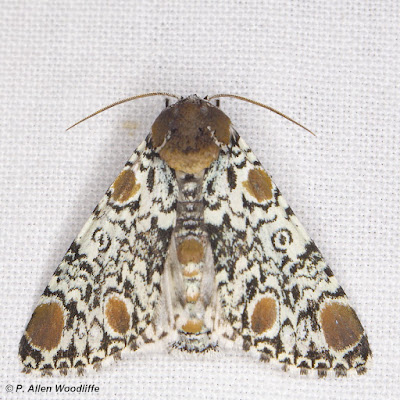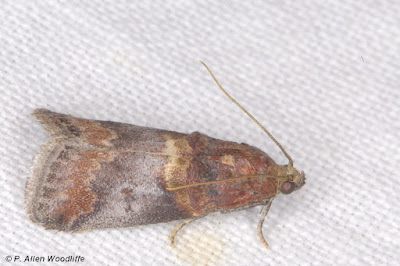Newport Forest is a wonderful natural treasure, tucked away on the south side of the meandering Thames River in Elgin County. It was a combination of woodland, creek valleys and abandoned farmland when it was acquired more than two decades ago by Kee and Pat Dewdney. The abandoned farmland was planted into various trees, shrubs and native herbaceous plants, and the Dewdney's undertook an ambitious plan to document all living things, plant or animal, to be found on the site. You can read much more about Newport Forest at this link.
A few years ago, the Dewdney's donated it to the Thames Talbot Land Trust, a well-organized and effective organization dedicated to preserving many natural areas within their area of interest.
 |
| Virginia Bluebells |
I have been there several times, usually upon invitation, and especially with the intent of enjoying the wonderful display of Virginia Bluebells in late April or early May, but even more so, to set up my black lights and survey for the night-time creatures that are drawn to the lit up sheets. Moths, of course, are my main target, although there are many other things that arrive.
It was this past weekend, at the end of National Moth Week, that I met Kee and we proceeded to set up the black lighting equipment in preparation for the arrival of some winged denizens of Newport. There were lots of non-moths, to be expected, and there was no shortage of caddisflies of various shapes, colours and sizes. They are difficult to identify to species, but this one apparently is Potamyia flava. I don't know if it has a common name or not.
But the moths were the main focus, and although we only had the lights on for a bit less than two hours, I photographed a little more than 40 species of moths. Most were to be expected, but some were notable for their provincial rarity. What follows are some of the more significant or colourful ones.
The first one, Currant Fruitworm Moth, is fairly small as you can tell in comparing it to the size of the weave of the sheet. There are very few records for Ontario, although it does not have any official status. It is the first record for Elgin, according to iNaturalist.
 |
| Delightful Dagger |
 |
| Flowing Line Snout |
On the very smallest scale of the moths was this next one: the Gooseberry Barkminer, a.k.a. White Eye-capped Moth. It is only about 6 mm in length.
 |
| Green Leuconycta |
 |
| Harris's Three-spot |
 |
| Hickory Leafstem Borer |
 |
| Hickory Shoot Borer |
 | |||
| Johnson's Euchlaena |
The American Lappet Moth, next, is not only fairly large and colourful, it has the distinct habit of not folding its forewing against the body and hindwing, but laying it somewhat flattened.
 |
| Mantled Acrobasis Moth |
 |
| Master's Dart |
 | |
| Painted Lichen Moth |
Some moths habitually have their wings folded in an upright position, at least part of the time.
Fortunately they will usually flatten them out, making this Red-fringed Emerald much easier to photograph and identify.
 |
| Sharp-angled Carpet |
The Splendid Palpita is fairly common and widespread.
Unfortunately this next one, which was formerly called Gypsy Moth but now called Spongy Moth, is not native and fairly common. It goes in cycles, and in 2021 it was extremely abundant. The current year is a lot better, and this is just the first one I have photographed this year and the only one we saw on this night. Last year I sometimes would get as many as 20 at a time on the sheet!
The Thin-winged Owlet, next, is quite distinctive in both form and pattern. It is Vulnerable in Canada, and on the NHIC list of rare species. It is widely scattered in mostly southwestern Ontario. This is the first record for Elgin Co., according to iNat.
 |
| Variegated Midget |
Underwing moths are in a class by themselves in terms of diversity and the very attractive pattern one may see on the hind, or under, wing. They are not often attracted to lights, so I was pleasantly surprised to see this one, known as the Wonderful Underwing. I didn't get a photo of its underwing colours and pattern which features black and orange bands.
 |
| Woodgrain Leafroller Moth |
I did show one non-moth at the beginning of this post. I don't often spend a lot of time photographing them, but some are nice to capture just the same.
This first one shows a pair of mating craneflies of the Limoniidae family.
Next is what may be a small mayfly known as one of the Blue-winged Olives. I photographed it unintentionally, as it was beside a much larger moth, but was able to crop the photo to get this critter as well.
And last, but not least, is a bug that has its own lighting ability, and may have come by to see what this larger white sheet lighting was all about. It is a Lightning Bug of the Photuris genus.
Kee and I are already discussing another black lighting event much later in the season, depending on the weather.
If you would like to subscribe, or unsubscribe, to Nature Nuggets, send an email to: prairietramper@gmail.com






















What a delightful place to be and quite a remarkable collection of moths. So varied in patterns, shapes and sizes. Wonderful to see. I'm so glad that there is someone like you who takes the dedicated trouble to do what you do. Highlighting and preserving the beauty of this world to share.
ReplyDeleteWhat a delightful place to be. Thank you for your dedication to photographing and sharing the beauty of our world. Those moths are incredible, such wonderful, varied patterns, shapes and sizes. How great is our God.
ReplyDeleteThank-you kindly, Paula. I count it a privilege to be able to have the opportunity to discover, photograph and share many of the fascinating elements of God's creation!
Delete